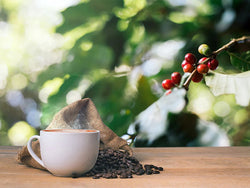
The Ultimate Guide to Coffee Beans: Types, Flavours & Brewing
Key Takeaways
- Coffee Beans & Origins: The two main coffee bean types, Arabica and Robusta, offer distinct flavour profiles. Arabica is smooth and complex, while Robusta is bold and high in caffeine. Regions like Ethiopia, Colombia, and Vietnam influence bean characteristics.
- Choosing & Storing Beans: The right coffee bean depends on roast level, acidity, and brewing method. To maintain freshness, store beans in an airtight container away from light, heat, and moisture.
- Best Beans for Brewing Methods: Espresso thrives with dark roasts, pour-over highlights bright acidity, and cold brew works best with smooth, low-acid beans. Selecting the right beans enhances the coffee experience.
Table of Contents
- Introduction
- Understanding Coffee Beans
- Types of Coffee Beans & Their Origins
- Choosing the Right Coffee Beans
- Storing Coffee Beans for Freshness
- Coffee Bean Acidity & Flavour Profiles
- Unique Coffee Bean Variations
- Brewing Methods & the Best Beans for Each
-
Conclusion
-
Additional Reading

Introduction
Coffee is more than just a beverage; it's a global culture, a daily ritual, and for many, an essential part of life. The journey from bean to cup is intricate, influenced by various factors that shape the final flavour. This guide delves deep into the world of coffee beans, exploring their types, origins, flavour profiles, and the best brewing methods to enhance your coffee experience.
Understanding Coffee Beans
Arabica vs Robusta: The Primary Coffee Species
The two most prominent coffee species cultivated for consumption are Coffea arabica (Arabica) and Coffea canephora (Robusta). Arabica beans account for approximately 60–80% of the world's coffee production, while Robusta comprises about 20–40%.
Arabica beans are renowned for their smooth, complex flavours with higher acidity. They typically contain 0.8–1.5% caffeine. Originating from the highlands of Ethiopia and the Boma Plateau of Sudan, Arabica plants thrive in cooler, high-altitude regions.
Robusta beans, on the other hand, are known for their strong, bold taste with a characteristic bitterness. They have a higher caffeine content, ranging from 1.5–4.0%. Robusta plants are hardier, resistant to pests and diseases, and can withstand warmer climates, making them easier to cultivate.
Key Differences Between Arabica and Robusta
- Flavour Profile: Arabica offers a wide range of flavours, from sweet and fruity to nutty and chocolaty. Robusta tends to have a stronger, more bitter taste with earthy notes.
- Caffeine Content: Robusta beans contain almost double the caffeine of Arabica beans, contributing to their more pronounced bitterness.
- Growing Conditions: Arabica plants prefer high altitudes with cooler climates, while Robusta can thrive in lower altitudes and warmer temperatures.
- Shape and Appearance: Arabica beans are oval-shaped with a curved crease, whereas Robusta beans are rounder with a straight crease.

Types of Coffee Beans & Their Origins
Single-Origin vs Blended Coffee Beans
Single-origin coffees are sourced from a specific region, country, or even a single farm. These coffees showcase the unique characteristics of their origin, influenced by factors like soil, climate, and altitude. For instance, Ethiopian coffees are often celebrated for their bright, fruity flavours, while Sumatran beans are known for their earthy, full-bodied profiles.
Blended coffees combine beans from multiple origins to achieve a balanced flavour profile. Roasters create blends to highlight desirable attributes from different beans, ensuring consistency and complexity in the cup.
Notable Coffee-Growing Regions and Their Flavour Profiles
- Ethiopia: Often considered the birthplace of coffee, Ethiopian beans, such as those from the Yirgacheffe region, are known for their bright acidity and floral, fruity notes.
- Colombia: Colombian coffees are well-balanced with medium acidity and a smooth, mild flavour, often featuring nutty and caramel notes.
- Brazil: As one of the largest coffee producers, Brazil offers beans with low acidity and chocolatey, nutty flavours.
- Vietnam: Predominantly producing Robusta beans, Vietnamese coffees are bold, full-bodied, and carry earthy, robust flavours.
-
Jamaica: Home to the renowned Blue Mountain coffee, Jamaican beans are smooth, mild, and well-balanced with subtle acidity.

Choosing the Right Coffee Beans
Selecting the perfect coffee beans depends on several factors:
Taste Preferences
Consider what flavours you enjoy in a coffee. Do you prefer bright and fruity notes or rich and chocolaty undertones? Single-origin coffees can offer distinctive flavours unique to their region, while blends provide a harmonious balance of multiple flavour notes. For more on single origin coffee, read our dedicated blog here.
Roast Level and Its Impact on Flavour
- Light Roast: Preserves the bean's original flavours, resulting in a bright, acidic cup with fruity or floral notes.
- Medium Roast: Balances acidity and body, offering a rounded flavour profile with caramel sweetness.
- Dark Roast: Emphasises bold, robust flavours with pronounced bitterness and reduced acidity, often with smoky or chocolaty notes.

Freshness and Grind Size
Freshly roasted beans yield the best flavours. Purchasing whole beans and grinding them just before brewing ensures maximum freshness. The grind size should match your brewing method; for example, a coarse grind suits a French press, while a fine grind is ideal for espresso.
Brewing Method Compatibility
Different beans complement various brewing methods. For instance, beans with bright acidity and complex flavours are excellent for pour-over, while bold, dark-roasted beans are suitable for espresso.
Storing Coffee Beans for Freshness
Proper storage is crucial to maintain the freshness and flavour of your coffee beans. Here are some best practices:
-
Keep Beans Airtight: Store beans in an airtight container to prevent exposure to air, which can lead to oxidation and staleness.
- Avoid Light and Heat: Place the container in a cool, dark place away from direct sunlight and heat sources.
- Minimise Moisture Exposure: Ensure the storage area is dry, as moisture can cause beans to deteriorate or develop mould.
- Buy in Small Quantities: Purchase coffee in amounts that you can consume within a few weeks to ensure continuous freshness.
- Avoid Freezing or Refrigeration: While some believe freezing coffee beans extends their lifespan, fluctuating temperatures can introduce moisture, leading to flavour degradation. If necessary, store beans in a vacuum-sealed bag in the freezer and only remove small portions as needed.
Continued: For more information on how to keep coffee beans fresh, read our complete guide here.
Coffee Bean Acidity & Flavour Profiles
Coffee acidity is a key factor in determining flavour. It does not refer to pH levels but rather to the bright, crisp taste that enhances a coffee’s complexity. Different beans have varying acidity levels:
- High Acidity: Often found in African beans (e.g., Ethiopian and Kenyan), contributing to citrusy, fruity, and floral notes.
- Medium Acidity: Central American beans, such as those from Costa Rica and Guatemala, tend to have balanced acidity with caramel-like sweetness.
- Low Acidity: Indonesian and Brazilian beans typically have lower acidity, resulting in smoother, earthier, and nuttier flavours.
For coffee lovers with sensitive stomachs, opting for low-acid beans or darker roasts can help reduce acidity’s impact.
Continued: Keen to know more about coffee bean acidity? Read our dedicated blog article here.
Unique Coffee Bean Variations
While Arabica and Robusta dominate the market, other unique coffee bean varieties exist:
- Liberica: A rare variety known for its bold, smoky, and fruity flavour profile. Primarily grown in the Philippines and Malaysia.
- Excelsa: A distinct species often used to add depth and tartness to coffee blends.
- Chicory Coffee: Although not technically a coffee bean, chicory root is roasted and brewed as a caffeine-free alternative, offering a rich, earthy taste.
Brewing Methods & the Best Beans for Each
Choosing the right brewing method can enhance a coffee’s unique characteristics. Here are some popular brewing methods and the best beans for each:
- Espresso: Dark-roasted, finely ground beans with a bold, concentrated flavour. Best suited for blends featuring Brazilian or Indonesian beans.
- French Press: Coarsely ground beans with a medium to dark roast, offering full-bodied coffee. Ethiopian and Sumatran beans work well.
- Pour-Over: Light to medium roasts with high acidity and bright flavours. Single-origin beans from Kenya or Colombia are ideal.
- Cold Brew: Coarse-ground beans with low acidity and chocolatey, nutty notes. Brazilian or Guatemalan beans perform well.
Conclusion
Understanding coffee beans is essential for making informed choices that enhance your coffee experience. From selecting the right bean type and roast level to proper storage and brewing techniques, every factor contributes to your perfect cup.
Primo Caffe offers a premium selection of coffee beans tailored to various preferences and brewing methods. Explore our range of high-quality coffee beans today and elevate your daily brew!
Additional Reading
If you're keen to keep reading up on Primo Caffe's range of content on coffee beans at large, find some quick access links below. Happy reading!
- What Is Chicory Coffee?
- Is Coffee Acidic?
- Arabica Coffee v Robusta Coffee
- What Are the Best Coffee Beans for Strong Coffee?
- What Is Single Origin Coffee?
- How To Store Coffee Beans
---
About the Author
Nicolas Di Stefano is a third-generation Master Roaster and Director of Primo Caffe. With decades of family tradition behind him, Nicolas combines time-honoured Italian roasting techniques with a passion for quality, delivering delicious coffee that Australians expect.


